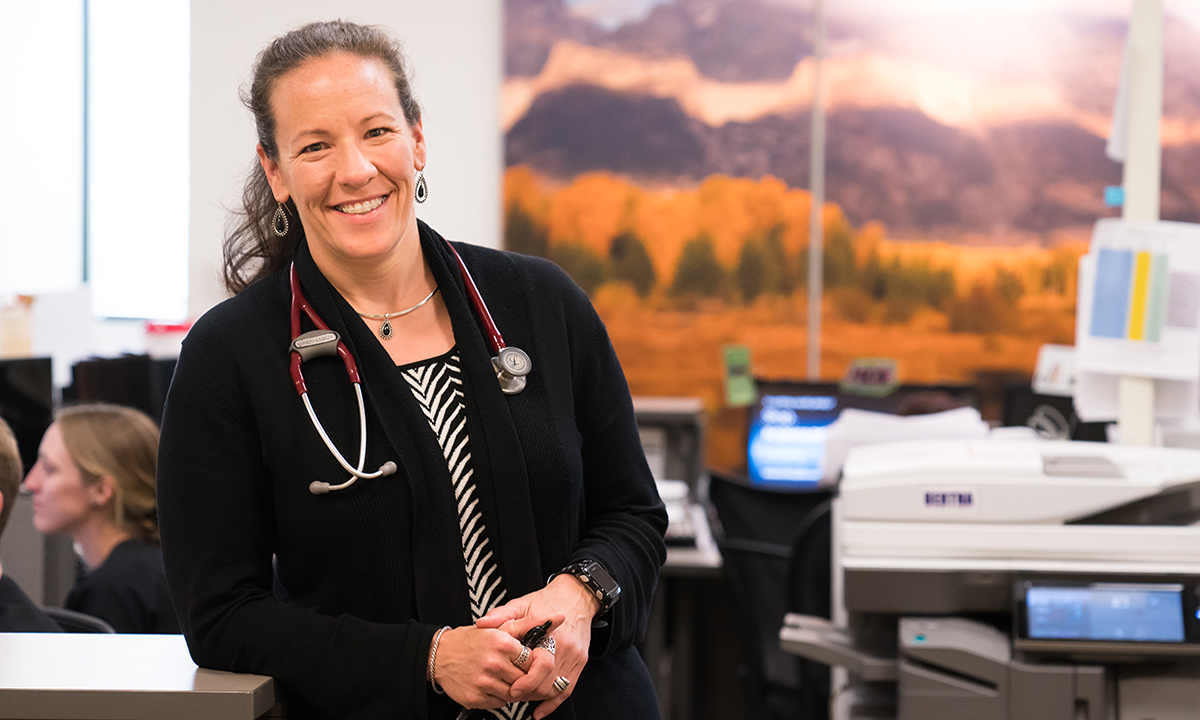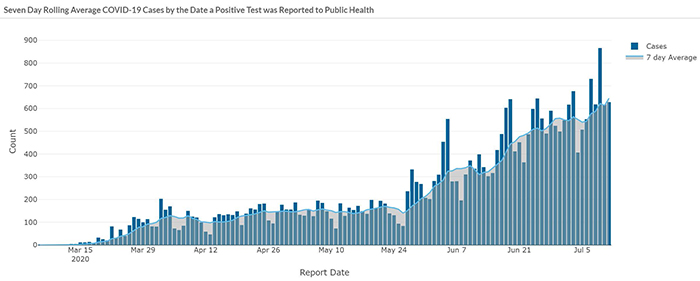
Integrating healthcare into the work place has allowed Dr. Gibson and her team to expedite contact tracing of employees who test positive to COVID-19. She states that the pandemic is an occupational health concern and companies need to have a long-term plan to address sick employees and those who have been exposed.
Like healthcare companies nationwide that have employees on the front lines, ARUP Laboratories implemented numerous safety protocols when the pandemic began. Now, as cases of COVID-19 surge in Utah and across the nation, the company is facing new challenges in preventing the spread of the virus among its 4,000-plus employees.
So far, the measures ARUP has implemented are working. To date, there has been only one episode of employee-to-employee spread, and it occurred before the corporate-wide mask mandate.
“We are an evidence-based company, and the evidence shows that what we are doing is working,” said Kathryn Gibson, MD, medical director of ARUP’s health and wellness operations. Other businesses may benefit from an understanding of what ARUP has done to keep employees safe and operations running strong.
Inside its facilities, ARUP requires the same safety measures recommended by infectious disease specialists nationwide: mandatory mask wearing, physical distancing, hand washing, and easy access to hand sanitizer. It also has upgraded ventilation systems in specific locations, added fogging to sanitize common areas, and is reconfiguring workspaces in labs and throughout its buildings.
To address the increased risk that employees face outside of work as cases rise, ARUP built on what it already had in place and ramped up the integration of healthcare into the workplace.

Protecting the Workforce: Actions When COVID First Hit
On March 3, 2020, The New York Times reported that six Americans had died from coronavirus and a hundred more were infected. The White House reassured the public that nearly a million tests would be available by the end of that week.
That same day at ARUP, leadership pulled together a team that began meeting twice weekly. It included representatives from risk management, supply chain, safety, communications, lab operations, human resources, IT, and transportation teams, along with staff from the ARUP Family Health Clinic.
“This team-based approach was to make sure all the appropriate groups were involved in the decisions being made and that we were hearing the different perspectives we needed to know to make the right decisions,” said Jonathan Genzen, MD, ARUP’s chief operating officer. “We were able to immediately start risk assessment based on every part of the company. This meant understanding our vulnerabilities as well as our opportunities.”
For example, Genzen pointed out that when the decision was made to enable a quarter of ARUP’s employees to work from home, ARUP needed to quickly expand software licensing for remote work tools and determine how to maintain strict privacy protections around off-site computer use. ARUP’s in-house IT group was able to facilitate this shift with little downtime for employees.
In a matter of two weeks, 900 employees were working from home. “We went from initially planning for people to work from home in case they became infected to having all employees who could work from home do so in order to avoid getting sick,” explained Robert Meeks, chief information officer.
ARUP leaders first relied on what they already had in place. The company began by reinforcing its commitment to employee health and wellness with consistent and clear messaging in verbal and written communication at all levels.
“When employees know that this matters to the company, then it matters to them, too. It makes them more mindful of caring for themselves, not just at work but outside of work, too,” said Gibson.
Trust is another value the company has sought to reinforce during this time of high anxiety. ARUP leaders recognized the importance of being transparent with employees. Daily (now weekly) emails from the CEO communicated the rapid changes happening at the company and the reasons for these changes. The messages were forthright about the company’s COVID-19 cases as well as the financial impact of the pandemic on the company. Employees could respond to these emails with questions via a feedback form and receive responses from executives. Leaders held a virtual town hall to answer previously submitted questions and share what they knew.
Leaders have had to be firm in their policies. For example, if an employee is unable to wear a conventional ear-loop mask for a particular reason (anxiety, skin sensitivity, etc.), alternatives are identified in collaboration with the safety department. ARUP made masks mandatory more than two months before Salt Lake County required them in all public spaces.
Transparency and frequent communication helped employees recognize that their own health and that of the company were related. If ARUP’s highly trained workforce gets sick, and the virus spreads, then the company can’t operate. “This holds people accountable for what they do outside of work,” added Gibson.
COVID-19 Is an Occupational Health Concern
The integration of an employee healthcare system into ARUP’s culture is a unique feature and has played a critical role in keeping employee cases low. Other companies could benefit from similar approaches, particularly those that must address occupational health needs, either in-house or by contracting with another provider. “COVID is an occupational health concern,” said Gibson, pointing out that the pandemic is not going away anytime soon and there may be future epidemics.
In the clinic’s early years (it was founded in 1992), it served only occupational health needs before gradually evolving into a full-fledged clinic to meet the primary care needs of some 10,000 patients (employees and their families). The clinic’s evolution has been shaped by the incentive to keep employee health costs low because ARUP is a self-insured company. (For more information about the role of ARUP’s health and wellness strategies, read “Decreasing Healthcare Costs by ‘Triaging’ Your Company.”)
“Regardless of the illness or need, we’re equipped to care for a sick employee as well as have an eye toward keeping our workforce safe,” explained Gibson, a primary care physician at the clinic. During the pandemic, the clinic has established a quarantine protocol and has relied on the established trust of employees to contact clinic staff. It has monitored test results and has performed its own contact tracing.
Based on a history of maintained confidentiality, employees trust the firewall established between the clinic and ARUP’s human resources. They know that their health information will be kept private. “Essentially, when you walk into the clinic, you are at a different company,” is how one former executive explained it.
The clinic closely follows HIPAA requirements but can immediately communicate with a supervisor when an employee needs to take sick leave to quarantine. This saves time. Compare this to the experience of a factory employee, for example, who would have to secure a note from a doctor, deliver it to a boss, and often involve human resources, too, to arrange leave time to quarantine. “This can lead to confusion, wasted time, and put the employee and employer in a tricky spot regarding PHI [personal health information],” said Gibson, adding that the sooner supervisors know a staff member will be absent, the sooner they can plan to avoid lost productivity.
Fast turnaround of COVID-19 test results and the ability to immediately follow through on contact tracing have allowed ARUP to prevent further spread of infection.
“When we have employees test positive, we can identify within the next few hours everyone at work and in their families who they have been in contact with and then have them quarantine and, if needed, tested,” said Gibson. With the current demands on health departments, contact tracing can take much longer.

Moving Forward
Although ARUP has had to learn as they go through this unprecedented crisis, one constant has been the employee-centric approach to all decisions. “There has not been a single moment when patients and our employees were not in the back of the mind when we were making decisions,” said Genzen. There have been operational and technical lessons learned, not always smoothly at first, but one of the things ARUP has done well, according to Genzen, is keeping employees safe while continuing to operate 24-7.
“So much is dependent on employees following the safety measures at work and outside of work, like wearing masks,” added Genzen. “We can’t emphasize that enough. It is what keeps us up and running.”
For many companies, strategies adopted to manage business during the pandemic will need to be kept in place longer term. Coronavirus cases continue to climb across the country and in Utah, where ARUP is based. The United States, which includes four percent of the world’s population, has 25 percent of the world’s coronavirus cases. In many states, economies are continuing to open up and soon many students will return to school. Traditionally, school reopenings each fall lead to a natural uptick in viral illnesses, kicking off the cold and flu season.
“As a business we need to be forward thinking,” said Gibson. “It’s not going to get better soon. We need to continue to be proactive and have a contingency plan in place in order to protect our employees and our operations.”
















